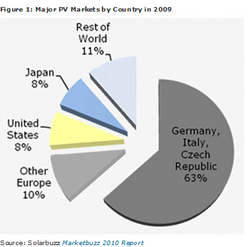Mar 18 2010
Worldwide solar photovoltaic (PV) installations reached a record high of 6.43 gigawatt (GW) in 2009-a 6% Y/Y growth, according to the latest Marketbuzz 2010 Report from Solarbuzz, an international solar energy market research and consulting company, and a division of The NPD Group. In addition, the company reported that the PV industry generated $38 billion in global revenues in 2009, while successfully raising more than $13.5 billion in equity and debt, up 8% on the prior year.
 Major PV Markets by Country in 2009, Source: Solarbuzz Marketbuzz 2010 Report
Major PV Markets by Country in 2009, Source: Solarbuzz Marketbuzz 2010 Report
According to the company's Marketbuzz 2010 Report, European countries accounted for 4.75 GW, or 74% of world demand in 2009. The top three countries in Europe were Germany, Italy and Czech Republic, which collectively accounted for 4.07 GW. All three countries experienced soaring demand with Italy becoming the second largest market in the world. In contrast, Spanish demand in 2009 collapsed to just 4% of its prior year level. The third largest market in the world was the US, which grew 36% to 485 MW. Following closely behind was a rejuvenated Japan, ranked fourth and growing 109% Y/Y.
Worldwide solar cell production reached a consolidated figure of 9.34 GW in 2009, up from 6.85 GW a year earlier, with thin film production accounting for 18% of that total. China and Taiwan production continued to build share and now accounts for 49% of global cell production. Of total European demand, net cell imports accounted for 74% of the total.
The top seven polysilicon manufacturers had 114,500 tons per annum of capacity in 2009, up 92% Y/Y, while the top eight wafer manufacturers accounted for 32.9% of global wafer capacity in 2009.
Solar cell production exceeding the market demand caused the weighted crystalline silicon module price average for 2009 to crash 38% from the prior year level. This reduction in crystalline silicon prices also had the effect of eroding their percentage premium to thin film factory gate pricing.
Looking forward, the industry will return to high growth in 2010 and over the next five years. Even in the slowest growth scenario, the global market will be 2.5 times its current size by 2014. Using the fastest growth forecast, annual industry revenues would approach $100 billion by 2014.
"Industry performance in 2009 was remarkable in that it managed to more than fully replace the 2.3 GW demand gap caused by the change in policy in Spain," remarked Craig Stevens, President of Solarbuzz. "Looking forward, the industry will see a return to high growth, but in a low margin environment. Our analysis demonstrates that a wide range of start-up markets will help offset a slowdown in German demand in the second half of 2010."
After providing a comprehensive look back at 2009 industry results, the report devotes one-third of its content to the 2010-2014 forecast, including a thorough preview of market developments, policies, prices and production requirements that are essential to shape corporate strategies over this period. Manufacturing costs, gross margins and capital expenditure profiles are also addressed. In total, the analysis in the new Marketbuzz 2010 Report references 112 countries across the world in 2009. Further details about the report's Content Outline and Figures/Tables are also available. For more information on the report, contact Charles Camaroto at 1.888.436.7673 or 1.516.625.2452, email contact(at)displaysearch(dot)com, or contact your contact your regional DisplaySearch office in China, Japan, Korea or Taiwan.